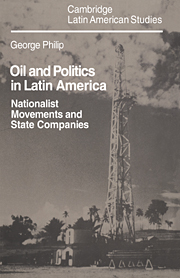Book contents
- Frontmatter
- Contents
- List of tables
- Preface
- Glossary
- Abbreviations
- Note on currencies and other units of measurement
- Maps: Latin America in 1920, 1940, 1960 and 1981; showing importing countries, exporting countries and countries self-sufficient in oil
- Introduction: The politics of oil in twentieth-century Latin America
- Part I The world oil environment
- Part II The major expropriations
- 7 Politics and the concession contract
- 8 Argentina: YPF, Yrigoyen and the 1935 oil law
- 9 Some nationalisations of the 1930s: Chile, Uruguay, Bolivia
- 10 Cárdenas and the Mexican oil nationalisation
- 11 The formation of Petrobrás
- 12 The nationalisation of the ipc in Peru
- 13 The nationalisation of Gulf Oil in Bolivia 1969
- 14 Oil politics in Ecuador 1972–6
- 15 The nationalisation of oil in Venezuela
- 16 Oil companies and governments in twentieth-century Latin America
- Part III The state oil companies
- Notes and bibliography
- Index
- CAMBRIDGE LATIN AMERICAN STUDIES
13 - The nationalisation of Gulf Oil in Bolivia 1969
Published online by Cambridge University Press: 23 December 2009
- Frontmatter
- Contents
- List of tables
- Preface
- Glossary
- Abbreviations
- Note on currencies and other units of measurement
- Maps: Latin America in 1920, 1940, 1960 and 1981; showing importing countries, exporting countries and countries self-sufficient in oil
- Introduction: The politics of oil in twentieth-century Latin America
- Part I The world oil environment
- Part II The major expropriations
- 7 Politics and the concession contract
- 8 Argentina: YPF, Yrigoyen and the 1935 oil law
- 9 Some nationalisations of the 1930s: Chile, Uruguay, Bolivia
- 10 Cárdenas and the Mexican oil nationalisation
- 11 The formation of Petrobrás
- 12 The nationalisation of the ipc in Peru
- 13 The nationalisation of Gulf Oil in Bolivia 1969
- 14 Oil politics in Ecuador 1972–6
- 15 The nationalisation of oil in Venezuela
- 16 Oil companies and governments in twentieth-century Latin America
- Part III The state oil companies
- Notes and bibliography
- Index
- CAMBRIDGE LATIN AMERICAN STUDIES
Summary
For some observers, the nationalisation of Gulf Oil appeared sudden and dramatic and a reflection of little more than the political instability within Bolivia. It will be argued here, however, that while there is a ‘spur of the moment’ element in any decision there were also a number of longer-term aspects of this nationalisation and that there was a broad ‘logic’ to this outcome. There were three elements in this. First, there was the nature of the initial Gulf contract itself and its effect upon the state company, YPFB. Second, and more important, there was the existence and growing strength of the nationalist faction within the army. Finally, there was Bolivia's own revolutionary tradition and history. In order to bring these out it will be necessary to begin this account in the mid-1950s.
The MNR period
The mnr leadership, which came to power with the 1952 Revolution, had never been opposed to all foreign investment in principle, although it had taken strong nationalist stands at various points in its history. Moreover, President Paz (who had earlier been Finance Minister in the 1943–6 government) believed that there were plentiful oil resources in Bolivia and that these needed to be developed if the country was to escape from its unrewarding and dangerous dependence on tin. However, given the lack of success with which pre-1952 governments had sought to attract foreign oil investment, it was evident to the MNR leadership that active co-operation from Washington was necessary.
- Type
- Chapter
- Information
- Oil and Politics in Latin AmericaNationalist Movements and State Companies, pp. 258 - 273Publisher: Cambridge University PressPrint publication year: 1982



